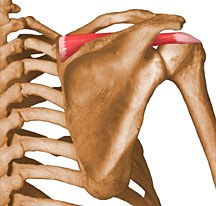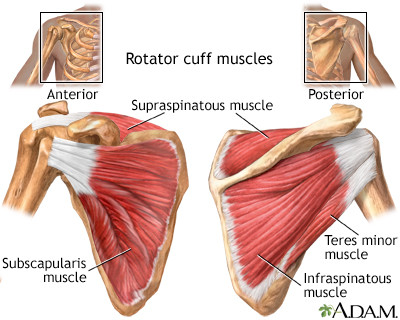Human Anatomy 101 - The Rotator Cuff
G'day team
This article will require a working understanding of anatomical terminology. If you haven't read my posts on understanding anatomical terminology you can find them here
Anatomy 101 - Anatomical Terminology (Basics)
Anatomy 101 - Anatomical Terminology (Detailed)
Preamble
So today I thought we'd chat about the rotator cuff. This set of muscles is both extremely important and often misunderstood. At the core of understanding the rotator cuff, is understanding how each muscle courses from it's point of stable attachment (origin) to it's point of insertion of the head of the humerus.
But before we jump into the details of the rotator cuff, we should first understand why it is such an important group of muscles.
Lifting, Swimming and Ageing
The rotator cuff has a significant importance in a few groups of people.
The first is lifters. As the rotator cuff is vital in stabilizing the shoulder joint, a weak rotator cuff can result in injury. A common scenario is someone who works out only the major muscles of the chest, shoulder, and back (pectoralis, deltoids, trapezius and latissimus dorsi) only to injure themselves when their rotator cuff is no longer able to effectively hold the humeral head in the glenoid fossa.
The second is in swimmers. The repetitive motion of arm rotation in swimming results in a lot of movement of the head of the supraspinatus through a narrow corridor under the acromion. This movement can result in swelling, leading to a further restriction in motion. The end result of this can often feel like pain at the front of the shoulder, as this is the attachment site of the supraspinatus muscle, though the problem lies in the space under the acromioclavicular joint.
The third is in the elderly. The rotator cuff is commonly torn in elderly individuals, and without proper rehabilitation may actually undergo a cycle of repetitive healing and tearing, eventually resulting in fibrosis of the muscle and conversion to fatty tissue. This can have a major impact on the ability of elderly individuals to lift simple objects such as groceries and kettles and may have a big impact on quality of life.
The Rotator Cuff
So let's get into it! The rotator cuff is a set of muscles whose primary role is to stabilize the shoulder during movements, as well as perform the actions of external rotation, internal rotation and abduction.
The Muscles
The rotator cuff is made up of four muscles:
- Supraspinatus
- Infraspinatus
- Subscapularis
- Teres minor
But to understand the rotator cuff as a whole we should look at each of these muscles individually
Supraspinatus
The name of this muscle refers directly to its position and means 'above the spine'. The supraspinatus sits above the spine of the scapula and superior to the bulk of the rest of the rotator cuff. The muscle passes laterally and anteriorly attaching to the head of the humerus in an anterolateral position. The role of the supraspinatus is two fold
- Prevent the head of the humerus slipping down
- Assist in abduction of the arm
Infraspinatus
Once again, the name of this muscle gives away its position. Lying inferior to the spine of the scapula and therefore inferior to the supraspinatus this muscle has quite a different role. The muscle attaches on the lateral border of the humeral head, but unline the supraspinatus does so by wrapping around the humeral head laterally, not from superiorly. As such the infraspinatus action is external rotation not abduction.
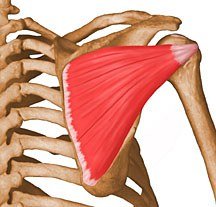
Image source
Subscapularis
Now we'll get a little more complex! The previous two muscles have been relatively simple to visualize, sitting on the posterior aspect of the scapula. The subscapularis, as its name suggests, sits below or on the anterior edge of the scapula. The muscle passes laterally and attaches directly to the anterior aspect of the humeral head, as such the subscapularis is an internal rotator, the only muscle of the rotator cuff to have this role.
Note this image is from the opposite direction of those above, in an anterior -> posterior view.
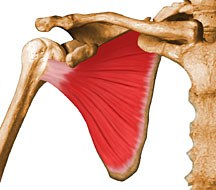
Image source
Teres Minor
Teres Minor is often considered the 'odd one out' when we're considering the rotator cuff, but this is largely due to the fact that it does not fit into the naming convention, and once we understand it's position it's easy to see that it is very similar to the Infraspinatus. (The 'odd one out' is really the subscapularis sitting on the wrong side of the scapula). Teres minor reaches from the lateral border of the scapula and attaches to the lateral border of the humeral head. As such the action of teres minor, just like the infraspinatus, is external rotation of the arm.
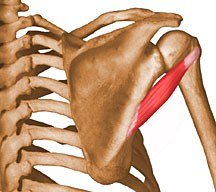
Image source
All Together
Thanks
Thanks for reading team and I hope you've found this helpful!
Thanks
-tfc
Recent Posts
Hi, I'm Tom! (My life of medicine, science and fantasy)
Super Bugs - What is antibiotic resistance and how we are fighting it
Hydatidiform Mole – When Pregnancy Goes Wrong
Tags - Top 20 Profitable, Engaging and Popular tags
New Years Resolutions - How to set goals, and achieve them
